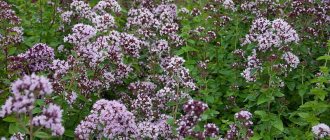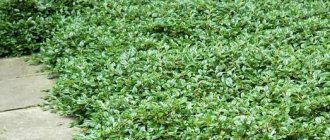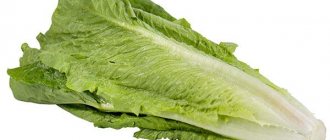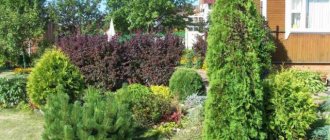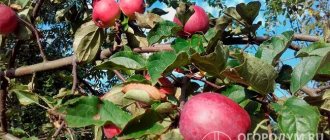Category: Mineral fertilizers Reading time: 8 min · Views: 3,913
Phosphorus fertilizers are necessary for the proper development of plants at all stages of the growing season. Ammophos is one of the most common agricultural fertilizers used in subsidiary farms. The popularity of the agrochemical provides a quick effect after application to the soil, thanks to the special formula of the active substance. Let's consider the composition of the fertilizer and the rules of use for feeding various crops. We will also consider the difference between ammophos and nitroammophos and ammophos.
What kind of fertilizer is this, composition
Ammophos is a highly concentrated mineral fertilizer that contains nitrogen and phosphorus. The ratio of the active components of Ammophos is 12:52 . The fertilizer is available in the form of soluble granules. There are no ballast substances in the composition.
Formula: NH4H2PO4 + (NH4)2HPO4.
This is a phosphorus-containing fertilizer, which is formed from 2 phosphates:
- monoammonium phosphate (NH4H2PO4);
- diammonium phosphate ((NH4)2HPO4).
Description of the features of the drug:
- The share of nitrogen is about 12%, phosphorus – from 45 to 52%.
- Phosphorus is contained in a water-soluble form and is easily absorbed in all soils. The granules are evenly distributed around the roots of seedlings and seeds; thanks to gradual dissolution, plant nutrition is provided for a long period.
- The fertilizer is hygroscopic, does not absorb moisture during storage and does not cake, and does not generate dust when applied to the soil.
Complex fertilizer replenishes the lack of easily digestible phosphorus, increasing plant productivity and the effectiveness of other types of fertilizing.
Are Ammophos and Ammofoska the same thing?
Gardeners often have doubts when choosing between Ammophos and Ammophos - what is the difference between the drugs?
Ammophosphate contains about 12% nitrogen in ammonium form, 15% phosphorus and potassium each, and about 14% sulfur. Fertilizers differ in composition and percentage of phosphorus. MAF fertilizer is an analogue of Ammophos, but has a different ratio of nitrogen and phosphorus (12-61).
Beneficial properties of mineral complex fertilizer
The action and use of ammophoska fertilizer according to the instructions is aimed at eliminating and preventing nutrient deficiency. These include the main ones - NPK and additionally sulfur as a trace element to improve metabolism.
Thanks to timely application of complex fertilizing, you can avoid:
- chlorosis, in which the leaves turn pale, turn yellow, and then fall off;
- poor absorption of nutrients - it seems that fertilizer was added to the soil, but the plants look weak and sick, they grow poorly and set few fruits, most of which fall off during the pouring process;
- changes in fruit shape;
- uneven coloring and delayed ripening;
- poor migration of nutritional components in plant tissues due to lack of phosphorus - the leaves turn blue in this case.
Ammofoska works on almost all types of soil, but sandstones and loams especially need it. Sand does not hold nutritional components well, since it is very loose and substances are washed out by rain or during watering. Phosphorus and nitrogen are poorly absorbed on clay, which affects the appearance of plants.
The ammonium form of nitrogen is considered the safest, since there is no accumulation of nitrates in fruits, therefore, the risk of poisoning when eating them disappears. Ammonium is better retained in the soil and decomposes for a long time - this ensures nutrition for crops throughout the entire growth period.
When using organic and mineral fertilizers, fruits synthesize sugar better, which is especially important for berries and fruits, potatoes. The nutritional value of the product is higher, since it contains more vitamins and minerals, because if they are not in the soil, the plant has nowhere to take nutrition from and transfer it into fruits. Therefore, when there is a shortage of crops, flowers are often dropped and the harvest becomes smaller as a result.
Use on different soils
Fertilizer is applied taking into account the characteristics of the soil to avoid oversaturation with nutrients.
Chernozem
For meadow, forest-steppe and sod-podzolic chernozems, Ammophos is used as the main fertilizer for growing grain crops, root crops, flax, and chlorophobic plant species.
Carbonate chernozems
Due to the high temperature during the period of active plant life, carbonate, southern and simple chernozems require a special approach. In these cases, Ammophos is most effective - the fertilizer composition is more effective than preparations with nitrate forms of nitrogen.
Chestnut soils
The drug is of particular importance when planting industrial crops. On chestnut soils and gray soils, the effectiveness of fertilizer increases under the condition of irrigated agriculture.
Composition and purpose of ammophoska
The basic formula of the composition includes 4 chemical elements: phosphorus (15%), sulfur (14%), nitrogen (12%) and potassium (15%). Calcium and magnesium are present in small amounts (0.5% each).
- Phosphorus – provides plants with the energy necessary for proper growth and development, stimulates abundant flowering and fruiting, and increases endurance. The fertilizer in question contains ammonium phosphate and potassium phosphate.
- Sulfur – converts nitrogen into an easily accessible and quickly digestible form that is completely absorbed by plants.
- Nitrogen (ammonium sulfate) – promotes the growth of green mass, the synthesis of elements and an increase in yield.
- Potassium (presented in the form of sulfate) – increases sugar content and oil content, improves taste and increases the shelf life of fruits, regulates water balance, supports the immune system of plants, and increases the number of ovaries.
Recommendations for application to summer cottages
Ammophos is used for growing tomatoes, cucumbers, melons and legumes, cabbage, and peppers. The most important preparation is for beets, potatoes, and grapes.
Recommendations for applying Ammophos to garden and summer cottage plots:
- To increase yield and increase the amount of starch in potatoes, 2 g of granules are added per hole .
- When growing grapes, the drug allows not only to saturate the plant with nutrients, but also to prevent the accumulation of nitrates in the berries. In the spring, treatment is carried out with a solution ( 400 g per 10 l of water ), after 2 weeks foliar feeding is applied (solution concentration - 150 g per 10 l ).
- For all types of beets, fertilizer is used to stimulate the accumulation of sugar in root crops and the removal of nitrates. 5 g of the drug is applied per .
Inexperienced gardeners sometimes have the wrong idea about what Ammophos is. The main mistake when using it in summer cottages is applying it to all crops in a row as a universal remedy. The fertilizer should be used with caution, the drug is quickly absorbed and if applied in excess, the acidity of the soil will increase. In some cases, it may be more appropriate to use superphosphate.
In greenhouses
This is the most effective product for complex use on greenhouse soil. The combination with nitrogen and potassium chemicals is especially effective.
Fertilizer cannot be used with chicken droppings, manure, lime and ash.
Ammophos combines well with potassium salt, ammonium nitrate, urea and potassium chloride.
Chlorella is often used as a biostimulant for watering plants - Ammophos is effective for creating a nutrient medium for cultivating algae.
How to use
Most garden plants need nutrition in early spring, as well as during the flowering period, so that the crops do not drop their inflorescences with future fruits.
At the beginning of the growing season, you can apply half the dosage:
- for root vegetables 10 – 15 grams;
- berries 8 – 15 grams;
- trees 25 – 50 grams;
- vegetables 10 - 15 grams.
Next, when flowering begins, apply the full dosage with the expectation of fruit set. After the plants have flowered, fertilizing is carried out again to stimulate fruiting.
Video: Ammofoska - pros and cons
In case of emergency feeding, if the leaves suddenly turn yellow or blue, you need to dilute the granules in warm water and spray the above-ground part. The time must be chosen in the morning or evening so that the solution is well absorbed. It is necessary to take into account that the nutrient liquid is better absorbed by the back side of the leaf, so you need to spray from both.
When using Ammophos you need to be careful. It happens that plants respond better to superphosphate, but diammonium phosphate is not suitable for them. It is better to leave it for potatoes, grapes or beets.
What is ammophos
Ammofoska fertilizer is a mineral complex fertilizer; it quickly dissolves in water, which makes it possible to use it as an irrigation. It contains no nitrates or aggressive substances (chlorine, sodium). The amount of ballast microelements is kept to a minimum. The fertilizer can be used on almost all types of soil. It is more effective to use on peat-bog, sandy and clay soils.
It is believed that ammophoska is advisable to use in regions where there is little rainfall. Plants there require more nitrogen. Ammophoska cannot be used in the fall, otherwise it will cause the growth of green mass, which is unacceptable in the fall. The use of this fertilizer is economically beneficial, since it can be purchased in any package, depending on the area of the cultivated area, and its price is lower than many organic fertilizers.
How to dilute ammophos in water
Liquid feeding remains the most effective way to fertilize cultivated plants. To prepare a nutrient solution from fertilizer:
- Pour 0.5 kg of ammophoska with 5 liters of hot water.
- Stir and wait until the residue settles out.
- Drain the liquid part and use it for root or foliar feeding.
- Add 2 more times 2.5 liters of hot water to the sediment and repeat the same operation again.
Since the components that are used as ballast in the production of such fertilizers include sulfur, the sediment after rinsing with water can be used as an additional element of compost or ground dressing.
The effect of ammophos on plants
Ammonium phosphate granules have a slightly grayish tint and are not standardized by diameter.
This substance does not spontaneously ignite and is safe in terms of explosion hazard. Ammonium phosphate is a source of readily available phosphorus for plants. This element is extremely important at the stage of root growth and the formation of reproductive organs. With phosphorus deficiency, defective flowers are often formed, there are few of them, fruit ripening takes longer, which reduces the overall crop yield.
Fertilizing with ammonium phosphate allows you to achieve the following positive effects:
- formation of a strong root system with good absorption capacity;
- increasing drought resistance of crops and their immunity to bacterial and fungal infections;
- improvement of flowering and fruit set;
- acceleration of ripening of fruits, roots and tubers;
- improving the quality of root crops and tubers.
As a result, overall crop productivity increases.
Expert opinion on the use of ammophos
Many agrochemists are working to study the effect of ammonium phosphate on plants. In particular, from 2005 to 2006, another study was conducted at the Prikumsk experimental station. Its practical results can be summarized as follows:
- Even if you abandon the main application of ammophos in the fall, and use it only during sowing, crop yields increase. For example, for barley the increase was 11%.
- The combined use of ammonium phosphate and ammonium nitrate increases productivity even more – up to 27%. Find out → how to use ammonium nitrate, properties + reviews.
- Ammophos exhibits its properties well on different types of soil. However, it showed the greatest effectiveness on chestnut, giving a fantastic increase in yield by 76%.
The collected data allowed experts to draw conclusions:
“The significant role of the highly concentrated complex fertilizer ammophos in increasing the yield of agricultural crops has been established. Its use in the initial period of plant growth promotes the development of a healthy root system, rapid formation of shoots and leaves, and increased resistance to drought and disease.”
E. Shustikova, E. Bogatyreva, N. Shapovalova, employees of the Stavropol Research Institute of Agriculture.
The scientists’ conclusions are confirmed by the practical experience of amateur gardeners who use ammonium phosphate on their plots:
“I have very bad soil at my dacha – all sand. Health does not allow us to transport manure there by carts, and the harvests, to put it mildly, were not encouraging. Involuntarily, I had to learn how to use mineral fertilizers. I tried to use superphosphate for phosphorus fertilizing (see → how to use superphosphate + reviews), but on my acidic soil it turned out to be almost useless. Ammophos helped out. I add it to the drip irrigation barrel twice - at the end of May and in mid-July. Finally I saw normal tomatoes!” (Anna, Leningrad region).
Instructions for preparation and use
Each crop has its own timing and norms for applying the fertilizer in question.
For flowers and lawn
Apply spring application. Fertilizer is embedded directly into the soil before planting to a depth of 3-5 cm.
Another way: having distributed the granules over the surface, sprinkle a small layer of earth, sawdust or sand on top. This is done to prevent nitrogen from evaporating from the fertilizer.
It is better to replenish the lawn by spraying with an aqueous solution of the drug. By feeding, the grass becomes juicier and thicker, and ornamental plants delight with the brightness of their colors and the duration of their flowering.
For potatoes
Ammophoska for potatoes is added in the amount of 1 tablespoon locally directly into the holes when planting tubers. The multicomponent composition of the fertilizer contributes to the proper development of the plant and the formation of an excellent harvest.
Adding ammophos as a top dressing increases the starchiness of potatoes, the number and size of tubers.
For peppers
Granules of the drug are added during digging (30 g / 1 m2) or when replacing soil. Adult plants are fed with a fertilizer solution (10 g per bucket of water).
For tomatoes
The drug is applied throughout the growing season. When planting seedlings, add ammophoska for tomatoes to the holes in dry form; during the flowering of tomatoes and ripening of fruits, water with the solution once every 14 days.
For pear
Spring application of the drug stimulates flowering and the appearance of ovaries. Further feeding will improve the taste and fruit filling. Due to the deep root system of trees, fertilizer is applied in liquid form.
For cucumbers
To improve soil fertility in the garden, when digging you need to add 20-30 g of granules per square meter of area, and then during the summer feed the plants with an ammophosphate solution every 10 days.
For onions and garlic
When planting, apply 20 g of dry fertilizer per 1 m2. During the growing season, spraying greenery will be of great benefit.
Advantages of using ammophos
This fertilizer has many advantages. Complex mineral fertilizing can be used on open soil, in greenhouses and greenhouses. Ammophoska works equally well everywhere. The drug is all-season, which makes it superior to other fertilizers. Fertilizing can begin as early as the end of March; it begins to work even at low temperatures. Fertilizers containing minerals begin to act faster than organic fertilizers. They are easier to use, odorless, and easy to transport. That is why Ammofoska is so often used both in personal farms and on a large scale.
Compliance with safety measures
Before fertilizing plants with fertilizers, you must take precautions and remember: ammophosphate has a hazard class of 4. You will need to wear a respirator or mask, work suit and gloves.
It is important to adhere to the following recommendations:
It is better to spray the product with a spray bottle so that it does not fly away in the form of dust, be sure to wash your hands with soap after work.- When cultivating the soil, it is advisable to ensure that fertilizers do not accidentally come into contact with the skin of the hands or open areas of the body.
- If the product gets into your eyes, rinse them under running water.
- In case of accidental ingestion, it is advisable to induce vomiting and drink plenty of water. Be sure to seek medical help.



